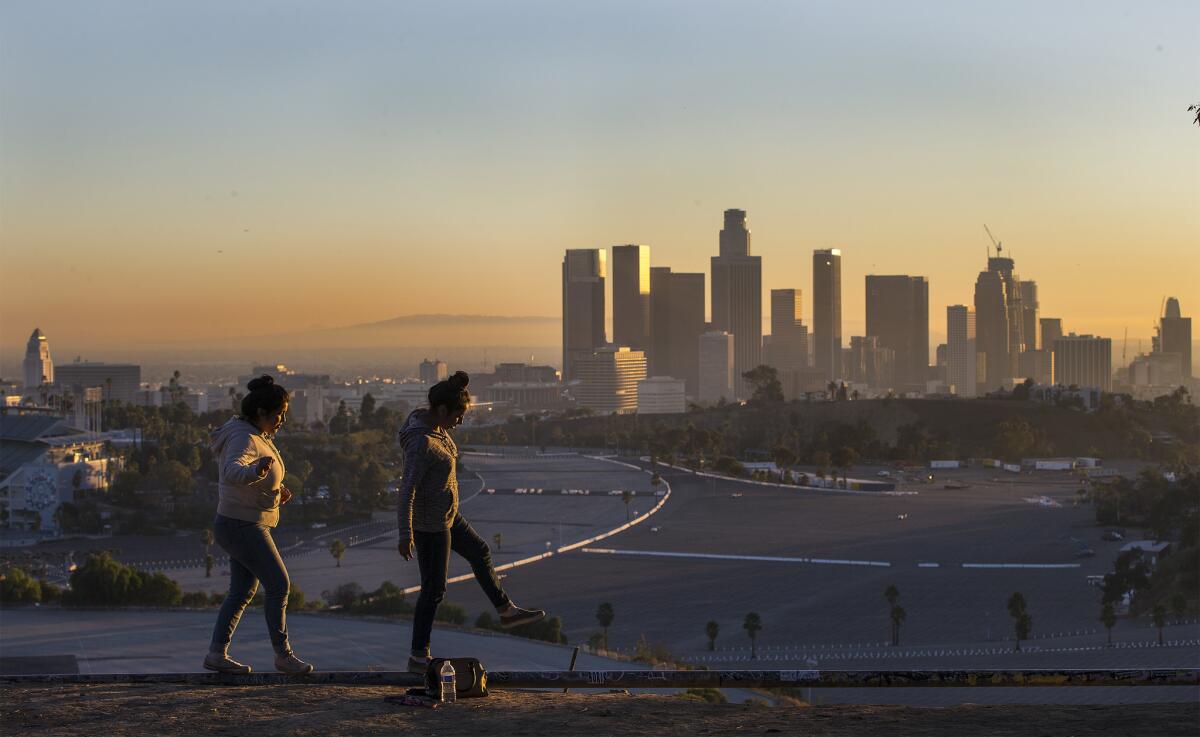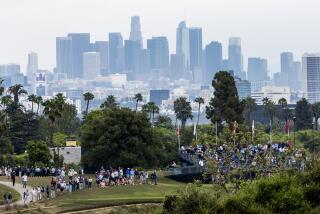Even in sunny L.A., warming climate may be the next big public health problem

With the L.A. skyline in the background, Stacey Martinez and Jessica Arellano balance on an old irrigation pipe on a dry slope at Angels Point in Elysian Park. LA’s temperature is expected to rise 5 degrees by midcentury, and public health officials are worried about what that’ll mean for Angelenos.
- Share via
For years scientists have warned that climate change will cause melting ice caps, rising sea levels and severe droughts and floods. But global warming’s effects can also be far more personal, seriously harming human health.
Most recently, the mosquitoes that can transmit the Zika virus, once found only in Africa and Asia, now breed all over the world, carrying the threat of new, sometimes deadly diseases.
The Aedes mosquitoes, which now live throughout Southern California, didn’t start spreading across the state until 2015, experts say. They prefer warmer climates. Last year was one of the hottest on record in the Southland, creating conditions “optimal for Aedes to expand,” said Kenn Fujioka, manager of the San Gabriel Valley Mosquito and Vector Control District.
Join the conversation on Facebook >>
The changing climate will not only bring new diseases, experts say, but also will threaten the water supply, worsen air quality and cardiovascular disease and cause deaths from extreme heat. From 2030 to 2050, nearly 250,000 people will die each year worldwide because of the health effects of climate change, according to the World Health Organization.
Local officials are beginning to grapple with the myriad ways that climate change could harm residents of the Los Angeles region, where warm weather, our favorite bragging right, is becoming the next big public health problem.
By 2050, the Los Angeles area is expected to warm by 5 degrees on average. Higher temperatures will create more smog, leading to more asthma and cardiovascular disease, including heart attacks. Water quality will also decline, experts say, because as water evaporates, the concentration of pollutants in the water becomes greater.
Angelenos will also suffer through more extreme heat, which already accounts for more deaths annually nationwide than flood, storms and lightning combined.
When it comes to climate change, “I look at health effects as the chief impact,” said Jonathan Parfrey, executive director of Climate Resolve, a Los Angeles nonprofit focused on adapting to climate change.
By midcentury, the number of extreme heat days — in which the high temperature exceeds 95 degrees — will triple or quadruple in parts of L.A. County if nothing is done to control greenhouse gas emissions.
In downtown Los Angeles, there could be 22 days of extreme heat a year by 2050, up from an annual average of six days recorded from 1981 to 2000. In the San Gabriel Valley, that number could jump to 74 from 32.
Unlike cities such as Phoenix and Tucson that regularly feel scorching temperatures, the L.A. region doesn’t have the infrastructure to deal with very hot weather — such as ubiquitous air conditioning — nor are residents in the habit of changing their behavior to avoid the heat, making them more vulnerable to its effects, said Elizabeth Rhoades, climate change lead for the Los Angeles County Department of Public Health.
For more than four decades, Mary Lawson, 67, has lived in a small home in South L.A. that doesn’t have air conditioning. Typically, when temperatures climb, she puts fans in all corners of her home.
“It would just be so hot that you could hardly stay there,” she said.
Yet Lawson did stay, not leaving her home until the evenings, enduring the worst of it indoors.
Such situations worry public health officials. When a heat wave struck California in 2006, with temperatures in the triple-digits for more than a week, 650 Californians died, Rhoades said. That’s in part because heat exacerbates existing medical conditions, such as diabetes and liver problems, she said.
One of the ways to mitigate these effects is to reduce the heat captured in cities. In highly urbanized neighborhoods, heat tends to get trapped, absorbed by the concrete and pavement of roads and buildings. That phenomenon, known as urban heat island effect, can increase temperatures by as much as 20 degrees over what they would otherwise be.
Last year, Lawson installed a “cool roof” made of materials that absorb less heat. She said she noticed last summer that it was a little cooler insider her home.
The city of Los Angeles’ sustainability plan aims to reduce the city’s urban heat island effect by 1.7 degrees by 2025. The city began requiring in 2014 that all new homes be built with such “cool roofs” and is testing a special kind of asphalt for roads that is supposed to absorb less heat.
Experts say focusing on urban heat island effect could bring significant benefits. A study released last year found that though other parts of California are hotter, the L.A. region has the worst urban heat island effect in the state, meaning temperatures here soar far higher.
Plus, the recent wave of homeowners in L.A. ripping out their lawns to save water during the drought may have aggravated the region’s heat problems, UC Riverside professor Donald Hodel said.
Grass is a cooler surface than dirt or pavement, he said, and even if the lawn was replaced with other plants, “often a drought-friendly landscape is going to have a lot of bare ground in it, so I don’t think you’re getting the same cooling effect.”
L.A. County has released two reports on the health effects of climate change, formed a committee to address the problems, and proposed planting more trees and building more parks to keep temperatures low — but little has been done yet.
Without significantly changing L.A. neighborhoods, extreme heat will have an outsized negative effect on poor communities, USC researcher Manuel Pastor said.
Low-income Angelenos not only tend to live in areas that lack green space, but they’re also less likely to have air conditioning or access to transportation to go somewhere cooler when temperatures soar, he said.
He compared the disproportionate effects of climate change on low-income people to the aftermath of Hurricane Katrina, in which many of the poorer residents of New Orleans didn’t have the transportation to get out when disaster struck.
“Climate change is real, but so is the climate gap,” Pastor said.
Twitter: @skarlamangla
ALSO
Orange County just launched its first clean-needle exchange
Without a ‘March miracle,’ drought-like conditions will continue in Southern California
L.A. County spends more than $233,000 a year to hold each youth in juvenile lockup
More to Read
Sign up for Essential California
The most important California stories and recommendations in your inbox every morning.
You may occasionally receive promotional content from the Los Angeles Times.











